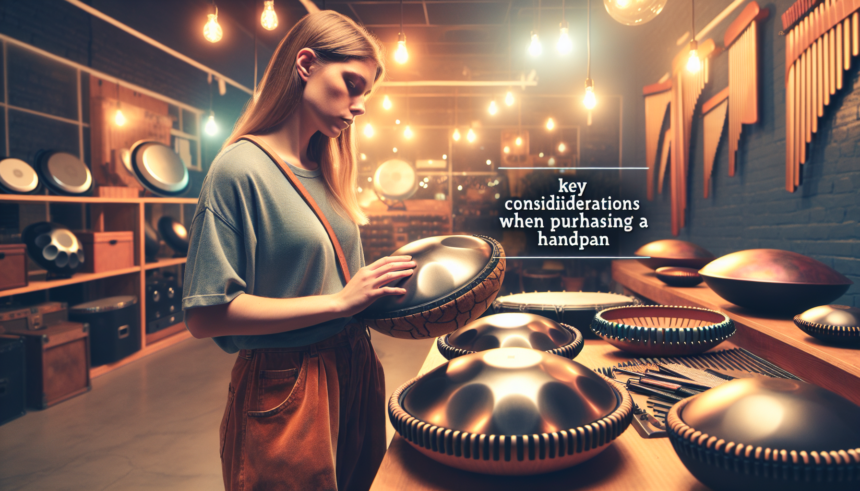<!DOCTYPE html>
<html lang="en">
<head>
<meta charset="UTF-8">
<meta name="viewport" content="width=device-width, initial-scale=1.0">
<title>Handpan Buying Guide</title>
<style>
body {
font-family: Arial, sans-serif;
line-height: 1.6;
margin: 0 20px;
}
h1, h2, h3 {
color: #2a2a2a;
}
p {
color: #555;
}
li {
margin-bottom: 10px;
}
</style>
</head>
<body>
<h1>Key Considerations When Purchasing a Handpan</h1>
<p>The handpan, also known as a hang drum, is a captivating and enchanting musical instrument that has gained popularity for its ethereal sound and unique design. Comprised of two metal shells, the handpan produces harmonic, resonant tones that can transport the listener to a tranquil, meditative state. However, purchasing a handpan can be a daunting process due to the array of options and the instrument's intricate craftsmanship. This guide will help you navigate the critical considerations when buying a handpan, ensuring you find one that fits your musical needs and personal preferences.</p>
<h2>1. Understanding Handpan Construction and Materials</h2>
<p>Handpans are typically crafted from either stainless steel or nitrided steel, each offering unique tonal qualities and durability. Stainless steel handpans often produce a brighter and more modern sound. They are valued for their resistance to rust and scratches, making them ideal for musicians who plan to perform in various environments. On the other hand, nitrided steel handpans have a warmer, more traditional sound and are appreciated for their vintage tonal qualities. However, they require more maintenance to preserve their condition.</p>
<p>Additionally, the thickness and tension of the metal can affect the richness and sustain of the sound. Thicker materials tend to offer longer sustain and richer harmonics, while thinner materials might yield a more percussive sound. It is important to consider which tonal qualities resonate with you as you explore different options.</p>
<h2>2. Scale Selection and Musical Compatibility</h2>
<p>Choosing the right scale is crucial when purchasing a handpan, as it determines the range of notes available to you. Handpans come in various scales, such as major, minor, pentatonic, and exotic scales, each evoking different emotions and musical atmospheres. The selection of scale should align with the genre of music you wish to play.</p>
<p>If you are a beginner, it might be wise to start with a versatile and common scale like D minor or C major, as they blend well with many types of music. More advanced musicians may seek out unique or less common scales to expand their musical horizons and experiment with distinct soundscapes.</p>
<h2>3. Design and Aesthetic Considerations</h2>
<p>The aesthetic appeal of a handpan often plays a significant role in the purchasing decision. Handpans are available in various finishes, colors, and designs, allowing players to choose an instrument that not only sounds beautiful but also reflects their personal style. Some handpans adopt minimalist, metallic finishes, while others boast colorful and intricate patterns. It's essential to find a balance between a visually appealing handpan and one that provides the acoustic qualities you desire.</p>
<h2>4. Budget and Investment</h2>
<p>The price of a handpan can vary significantly, influenced by factors like craftsmanship, material, and brand reputation. Entry-level handpans might start around a few hundred dollars, while high-end, custom-made handpans can cost several thousand dollars. It's important to consider handpans as an investment, not only in monetary terms but also in your growth as a musician. A higher quality handpan often offers superior sound quality and playing experience, which can greatly enhance your enjoyment and musical development.</p>
<p>Be wary of exceptionally low-priced handpans, as they may compromise on quality and craftsmanship. Investing in a reliable, well-crafted handpan will ensure its longevity and your long-term satisfaction.</p>
<h2>5. Buying from Reputable Makers</h2>
<p>Purchasing a handpan from a reputable maker ensures that you receive an authentic instrument crafted with precision and care. Many established handpan makers have honed their techniques over years, consistently producing high-quality instruments. Research and explore customer reviews, testimonials, and videos showcasing the sound of the handpans they manufacture.</p>
<p>Additionally, consider reaching out to the maker or a knowledgeable salesperson to discuss your preferences and address any questions you have. A reputable maker will provide guidance and assist you in finding a handpan that aligns with your needs.</p>
<h2>6. Testing and Evaluating the Handpan</h2>
<p>If possible, try out a handpan before purchasing it. This allows you to experience how it feels in your hands, the ease of playability, and its resonance with your personal playing style. Pay attention to the clarity and consistency of each note, the comfort of the layout, and the overall sound quality.</p>
<p>If you are buying remotely, request audio or video samples to hear the specific handpan you are considering. Some makers also offer a trial period or satisfaction guarantee, allowing you to return the instrument if it doesn't meet your expectations.</p>
<h2>7. Consideration for Portability and Care</h2>
<p>Handpans are often played in various environments, from streets and parks to studios and concert stages. Therefore, portability is a key consideration. Opt for handpans that come with a reliable case or bag to protect the instrument during transport and storage. Consider the weight and size if you anticipate frequent travel with the handpan.</p>
<p>Moreover, maintaining your handpan involves regular cleaning and care to prevent rust and wear, especially in humid or coastal regions. Understanding the care instructions provided by the maker will help extend the life and quality of the instrument.</p>
<h2>8. Establishing Your Musical Goals</h2>
<p>Before purchasing a handpan, reflect on your musical aspirations and goals. Are you looking to incorporate the handpan into your professional performances, or do you intend to use it for personal meditation and relaxation? Are you hoping to record and produce music with this instrument?</p>
<p>Understanding your musical intentions will guide your choice in terms of scale, brand, and investment level. It will help you focus on finding a handpan that aligns with your artistic vision and fulfills your intended purpose.</p>
<h2>Conclusion</h2>
<p>Purchasing a handpan is a personal and rewarding journey that involves evaluating various factors such as material, scale, aesthetic design, budget, and reputable craftsmanship. By considering these key aspects, you can find a handpan that resonates with your musical aspirations and personal style. Whether you are a beginner or an experienced musician, the right handpan will be a cherished companion, providing endless opportunities for musical exploration and creation.</p>
<h2>Frequently Asked Questions (FAQs)</h2>
<ol>
<li>
<strong>Do I need prior musical experience to play a handpan?</strong>
<p>No, the handpan is accessible to both beginners and seasoned musicians. Its intuitive design allows anyone to create beautiful melodies with ease. However, practice and exploration will enhance your playing skills over time.</p>
</li>
<li>
<strong>Can the handpan be played with other instruments?</strong>
<p>Yes, the handpan can blend harmoniously with various instruments such as strings, wind instruments, and percussion. Its melodious tones complement a wide range of musical genres and ensemble settings.</p>
</li>
<li>
<strong>How often should I tune my handpan?</strong>
<p>Handpans are typically designed to maintain their tuning for extended periods. However, exposure to extreme temperatures and humidity can affect tuning. It's advisable to have it checked annually by a professional for any necessary adjustments.</p>
</li>
<li>
<strong>What is the average lifespan of a handpan?</strong>
<p>With proper care and maintenance, a handpan can last many years. The quality of craftsmanship and materials used in its construction also play a significant role in its longevity.</p>
</li>
<li>
<strong>Can a handpan be repaired if it gets damaged?</strong>
<p>Minor scratches or dents can often be repaired by experienced professionals. However, severe damage may be more challenging to fix. It's essential to handle and transport your handpan with care to prevent such issues.</p>
</li>
</ol>
</body>
</html>Key Considerations When Purchasing a Handpan

Leave a comment




